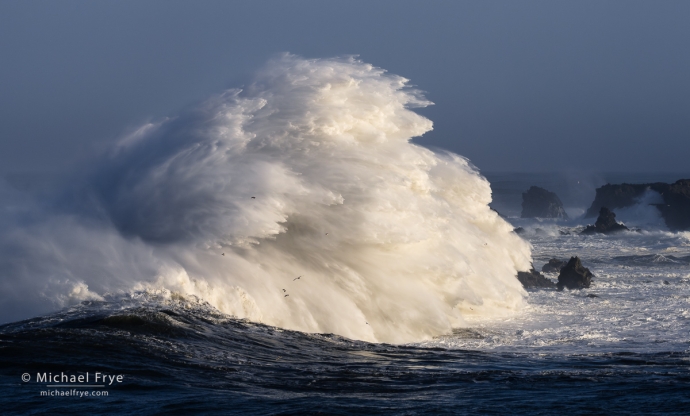
Breaking wave, Oregon Coast (from last Wednesday morning). This is one of the largest wave splashes I’ve ever seen. Note the gulls in front of the wave (you can click on this to see it larger). 192mm, 1/500 sec. at f/16, ISO 640.
After our Oregon Coast workshop Claudia and I hung around for a few more days, since we love this area, and the weather models were showing that more big waves were possible.
And I’m glad we stayed, as we did see some large waves last Monday, and then even bigger ones on Wednesday, after the “bomb cyclone” brought winds and heavy rain to the area on Tuesday and Tuesday night.
It was the storm’s winds on Tuesday that created Wednesday’s waves. All waves are formed by wind; it’s the wind that pushes and piles the water up into bigger and bigger waves. The stronger the winds, and the longer they blow, the bigger the waves. Wind-generated swells can travel thousands of miles across the ocean, but along the west coast of North America the biggest waves are propelled by nearby storms with strong winds.
Late on Tuesday afternoon, as the winds and rain increased, Claudia and I drove to a bluff overlooking the ocean to watch the storm. The waves were already large, and the wind was howling from the south, blasting impressive quantities of spray off the top of the waves. (No, I don’t have photos of that, because I didn’t want to get out of the car!)
By Wednesday morning the storm was clearing, but the storm-generated waves were still rolling in, and were impressively large, with swells around 20 feet or so. Probably the largest waves I’ve ever seen.
We went to a spot along the coast I wanted to return to. During our recent workshop we’d been able to photograph from that spot with some big waves, but on that day the light was rather flat by the time we got there.
On Wednesday morning the waves were even bigger, and there seemed to be a decent chance that the sun would break through and light the breaking waves. That happened eventually, as you can see from the photograph above, but it took awhile.
Around sunrise a bank of clouds lingered to the east and blocked the sunlight, so I went to a different spot nearby and photographed clouds lit by the rising sun. We saw some huge breakers rolling in, but the light on the water was rather flat. A little later I noticed a beautiful golden glow on the waves – not direct sunlight yet, but soft, warm, directional light as sunlight filtered through some thin clouds.
So I scurried over to my chosen spot, and happily spent the next hour or so photographing the waves rolling in. Although I liked that golden glow, I thought direct, low-angle sunlight would better complement and enhance the drama of the big waves. And after about 30 minutes I got what I was hoping for.
But everything still hadn’t quite some together. As any surfer knows, waves come in sets. There can be long lulls with smaller swells. (Though of course it’s all relative; “smaller” on this day would have been very large on most days.) Then, eventually, a set of larger waves comes in. Sometimes the set contains only a few bigger waves. Sometimes the set lasts for 20, 30 waves or more, and for several minutes.
The sun first broke through the clouds during one of those lulls, when the waves were relatively calm. Then clouds covered the sun again just as a bigger set came in. After what seemed like an eternity (but was in reality only a few minutes), the sun came out again, and shortly afterward an enormous set of waves rolled ashore, leading to a series of gigantic, awe-inspiring wave splashes. Everything had finally come together as I’d hoped. The photograph at the top of this post shows the largest of those splashes.
At this location I’m looking out across the water, with a telephoto lens aimed toward a distant group of rocks. The waves would roll in from left to right in front of those rocks, hit a reef, and, if it hit just right, generate a huge splash that completely hid the rocks behind.
I was using my 100-400mm zoom, but made sure to zoom out far enough to accommodate a bigger-than-expected wave. I’d rather zoom out too wide, and have to crop a little bit later, than cut off the top of the largest wave of the day. Luckily I was zoomed out wide enough (192mm) to fit this enormous wave in the frame.
It’s hard to judge the scale in a photograph like this. The gulls silhouetted against the wave give some idea. In sheer volume it’s probably the largest wave splash I’ve ever seen, though perhaps not the tallest. I may have seen waves splash higher than this in some spots, where the wave crashes against a rock or cliff, and the wave’s energy gets directed upward. Here, however, most of that energy was directed horizontally, to the right, yet the height was still tremendous – way over my head, even though I was standing on a bluff 70 feet above sea level. The explosive power was extraordinary, and amazing to witness in person.
I’ve included more photographs from the big-wave days last Monday and Wednesday below. Again, it was great fun to photograph these waves, and just watching them was a beautiful, awe-inspiring experience. I spent long periods of time (especially when the light wasn’t great) just watching the ever-changing spectacle of the waves stacking up, curling, and breaking against the shore. I don’t think I could ever get tired of seeing that.
— Michael Frye
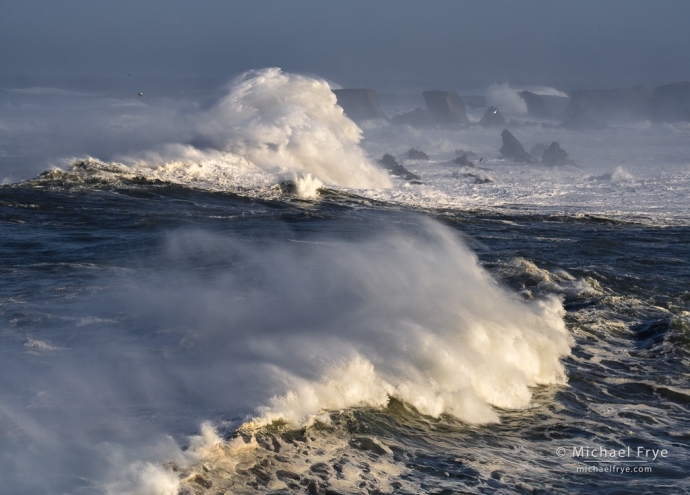
Waves and rocks, Oregon Coast. I made this image less than 30 seconds after the photograph at the top of this post, zooming out a little to include the breaking wave at the bottom of the frame. The bigger splash in the distance was essentially a smaller version of the wave shown at the top of this post, kicking up from the same spot. 173mm, 1/500 sec. at f/16, ISO 640.
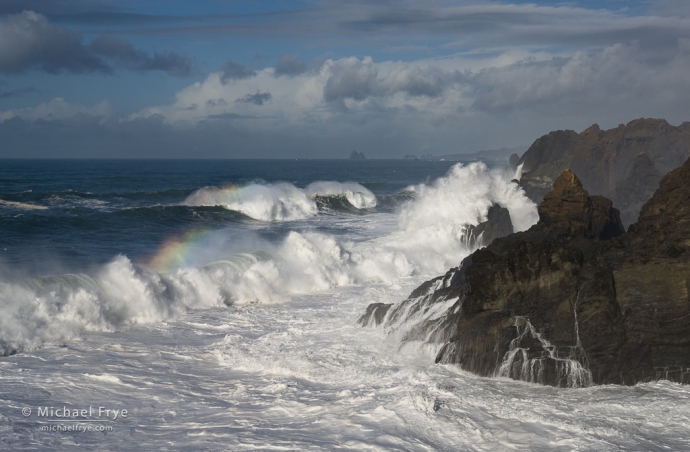
Waves and rainbow, Oregon Coast. This image is from last Monday morning, with “merely” 15-foot waves. 46mm, 1/500 sec. at f/11, ISO 320.
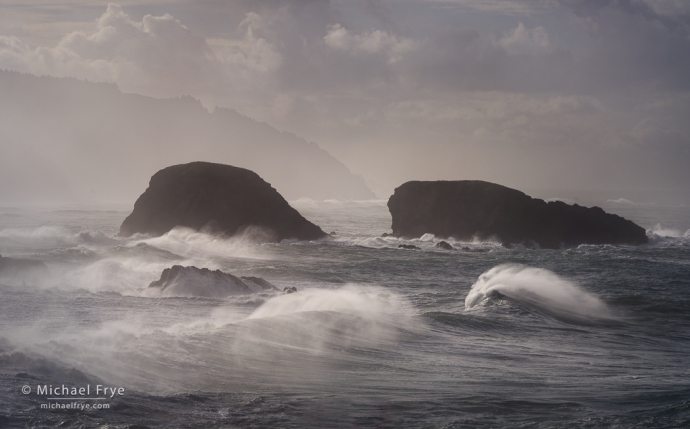
Waves, rocks, and clouds, Oregon Coast. Also from Monday morning, with beautiful rooster tails blowing off the tops of the waves. 126mm, 1/500 sec. at f/16, ISO 200.
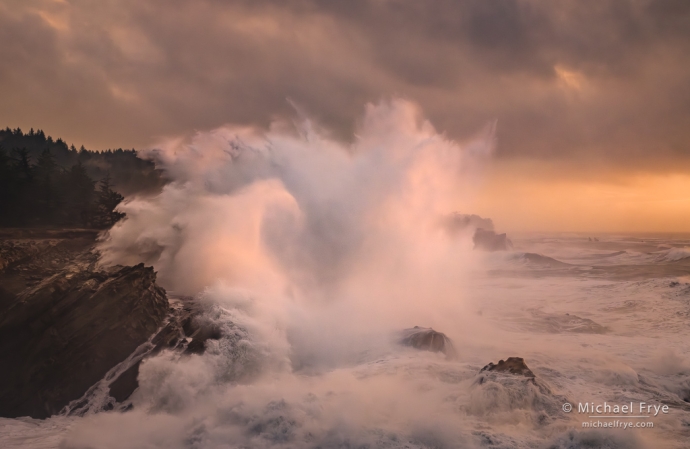
Wave splash at sunset, Oregon Coast. It rained steadily Wednesday afternoon, but just before sunset we saw signs of clearing, so I rushed out just in time to catch this beautiful champagne light. 60mm, 1/500 sec. at f/8, ISO 1600.
Related Posts: Storms and Waves Along the Oregon Coast; Motion and Mood Along the Oregon Coast
Michael Frye is a professional photographer specializing in landscapes and nature. He lives near Yosemite National Park in California, but travels extensively to photograph natural landscapes in the American West and throughout the world.
Michael uses light, weather, and design to make photographs that capture the mood of the landscape, and convey the beauty, power, and mystery of nature. His work has received numerous awards, including the North American Nature Photography Association’s 2023 award for Fine Art in Nature Photography. Michael’s photographs have appeared in publications around the world, and he’s the author and/or principal photographer of several books, including Digital Landscape Photography: In the Footsteps of Ansel Adams and the Great Masters, and The Photographer’s Guide to Yosemite.
Michael loves to share his knowledge of photography through articles, books, workshops, online courses, and his blog. He’s taught over 200 workshops focused on landscape photography, night photography, digital image processing, and printing.

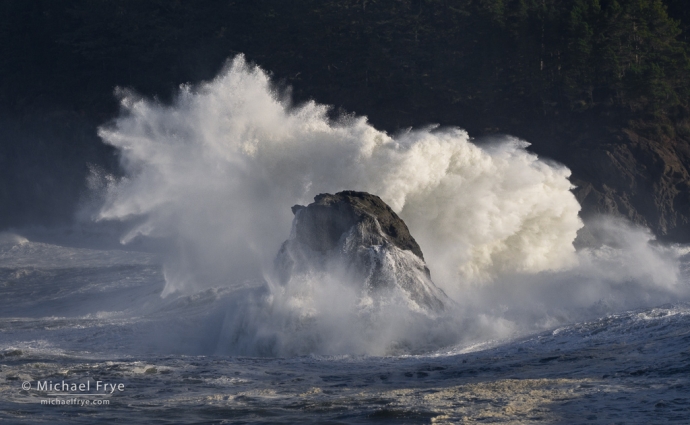








Incredible images, Michael. The power and beauty of the ocean is just tremendous. It must have been so thrilling to experience this show of nature.
Wishing you and Claudia a Happy Thanksgiving!
Thanks so much Bob, and Happy Thanksgiving to you too!
I love that last photo, Michael. The golden hue is beautiful!
I hope you, Claudia, and your family have a wonderful Thanksgiving!
Thanks very much Vivienne, and Happy Thanksgiving to you too!
Beautiful. Last week I saw the storm developing and wanted to head to the coast but alas I had commitments mid week. You caught a great storm. We’ll done
Thanks so much Paul – and sorry you weren’t able to make it out to the coast.
Hi Michael, I especially like the photo titled “wave splash at sunset” with the orange color in sky, on the horizon and in the waves and spray. It has an abstract feeling to it and reminds me of seascape paintings by JMW Turner, a well known British painter. His paintings often had a red, orange or yellow glow to them. Many examples on the internet.
Thanks Dan. I’m familiar with JMW Turner, and that photo does have a painterly feeling to it – glad you like it!
Hi Michael, I was really wishing I could have gone up to Oregon or NorCal for those waves, so I’m really glad to see you were there to photograph them! I knew it would be beautiful and awesome, and your photos show that perfectly. Thanks for sharing.
Thank you Stephen – and sorry you weren’t able to make it up there for the waves!